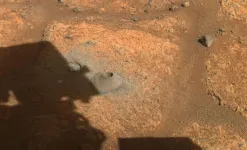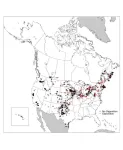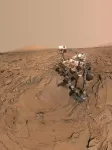In the journal Proceedings of the National Academy of Sciences, a seven-member team, funded by the John Templeton Foundation and led by Jim Cleaves and Robert Hazen of the Carnegie Institution for Science, reports that, with 90% accuracy, their artificial intelligence-based method distinguished modern and ancient biological samples from those of abiotic origin.
“This routine analytical method has the potential to revolutionize the search for extraterrestrial life and deepen our understanding of both the origin and chemistry of the earliest life on Earth,” says Dr. Hazen. “It opens the way to using smart sensors on robotic spacecraft, landers and rovers to search for signs of life before the samples return to Earth.”
Most immediately, the new test could reveal the history of mysterious, ancient rocks on Earth, and possibly that of samples already collected by the Mars Curiosity rover’s Sample Analysis at Mars (SAM) instrument. The latter tests could be conducted using an onboard analytical instrument nicknamed “SAM” (for Sample Analysis at Mars. (NASA photos at https://bit.ly/3P8V8II).
“We’ll need to tweak our method to match SAM’s protocols, but it’s possible that we already have data in hand to determine if there are molecules on Mars from an organic Martian biosphere.”
“The search for extraterrestrial life remains one of the most tantalizing endeavors in modern science,” says lead author Jim Cleaves of the Earth and Planets Laboratory, Carnegie Institution for Science, Washington, DC.
“The implications of this new research are many, but there are three big takeaways: First, at some deep level, biochemistry differs from abiotic organic chemistry; second, we can look at Mars and ancient Earth samples to tell if they were once alive; and third, it is likely this new method could distinguish alternative biospheres from those of Earth, with significant implications for future astrobiology missions.”
The innovative analytical method does not rely simply on identifying a specific molecule or group of compounds in a sample.
Instead, the researchers demonstrated that AI can differentiate biotic from abiotic samples by
detecting subtle differences within a sample’s molecular patterns as revealed by pyrolysis gas chromatography analysis (which separates and identifies a sample’s component parts), followed by mass spectrometry (which determines the molecular weights of those components).
Vast multidimensional data from the molecular analyses of 134 known abiotic or biotic carbon-rich samples were used to train AI to predict a new sample’s origin. With approximately 90% accuracy, AI successfully identified samples that had originated from:
Living things, such as modern shells, teeth, bones, insects, leaves, rice, human hair, and cells preserved in fine-grained rock Remnants of ancient life altered by geological processing (e.g. coal, oil, amber, and carbon-rich fossils), or Samples with abiotic origins, such as pure laboratory chemicals (e.g., amino acids) and carbon-rich meteorites.
The authors add that until now the origins of many ancient carbon-bearing samples have been difficult to determine because collections of organic molecules, whether biotic or abiotic, tend to degrade over time.
Surprisingly, in spite of significant decay and alteration, the new analytical method detected signs of biology preserved in some instances over hundreds of millions of years.
Says Dr. Hazen: “We began with the idea that the chemistry of life differs fundamentally from that of the inanimate world; that there are ‘chemical rules of life’ that influence the diversity and distribution of biomolecules. If we could deduce those rules, we can use them to guide our efforts to model life’s origins or to detect subtle signs of life on other worlds.”
“These results mean that we may be able to find a lifeform from another planet, another biosphere, even if it is very different from the life we know on Earth. And, if we do find signs of life elsewhere, we can tell if life on Earth and other planets derived from a common or different origin.”
“Put another way, the method should be able to detect alien biochemistries, as well as Earth life. That is a big deal because it's relatively easy to spot the molecular biomarkers of Earth life, but we cannot assume that alien life will use DNA, amino acids, etc. Our method looks for patterns in molecular distributions that arise from life's demand for "functional" molecules.
“What really astonished us was that we trained our machine-learning model to predict only two sample types – biotic or abiotic – but the method discovered three distinct populations: abiotic, living biotic, and fossil biotic. In other words, it could tell more recent biological samples from fossil samples – a newly plucked leaf or vegetable, say, versus something that died long ago. This surprising finding gives us optimism that other attributes such as photosynthetic life or eukaryotes (cells with a nucleus) might also be distinguished.”
To explain the role of AI, co-author Anirudh Prabhu of the Carnegie Institution for Science uses the idea of separating coins using different attributes – monetary value, metal, year, weight or radius, for example – then going further to find combinations of attributes that create more nuanced separations and groupings. “And when hundreds of such attributes are involved, AI algorithms are invaluable to collate the information and create highly nuanced insights.”
Adds Dr. Cleaves: “From a chemical standpoint, the differences between biotic and abiotic samples relate to things like water solubility, molecular weights, volatility and so on.”
"The simple way I would think about this is that a cell has a membrane and an interior, called the cytosol; the membrane is pretty water-insoluble, while the cell's content is pretty water-soluble. That arrangement keeps the membrane assembled as it tries to minimize its components' contacts with water and also keeps the ‘inside components’ from leaking across the membrane.”
“The inside components can also stay dissolved in water despite being extremely large molecules like chromosomes and proteins,” he says.
“So, if one breaks a living cell or tissue into its components, one gets a mix of very water-soluble molecules and very water-insoluble molecules spread across a spectrum. Things like petroleum and coal have lost most of the water-soluble material over their long histories.”
“Abiological samples can have unique distributions across this spectrum relative to each other, but they are also distinct from the biological distributions."
The technique may soon resolve a number of scientific mysteries on Earth, including the origin of 3.5 billion-year-old black sediments from Western Australia (photo at https://bit.ly/3YWbZ4Z) — hotly debated rocks that some researchers contend hold Earth’s oldest fossil microbes, while others claim they are devoid of life signs.
Other samples from ancient rocks in Northern Canada, South Africa, and China evoke similar debates.
“We’re applying our methods right now to address these long-standing questions about the biogenicity of the organic material in these rocks,” Hazen says.
And new ideas have poured forth about the potential contributions of this new approach in other fields such as biology, paleontology and archaeology.
“If AI can easily distinguish biotic from abiotic, as well as modern from ancient life, then what other insights might we gain? For example, could we tease out whether an ancient fossil cell had a nucleus, or was photosynthetic?” says Dr. Hazen.
“Could it analyze charred remains and discriminate different kinds of wood from an archeological site? It’s as if we are just dipping our toes in the water of a vast ocean of possibilities.”
* * * * *
Comments
“Cleaves and colleagues’ innovative method of distinguishing biological from abiotic organic matter is a gift for astrobiologists and, quite possibly, for students of Earth’s early history as well. There is much still to be learned, but one day a next-generation version of their system may well fly to Mars, evaluating the possibility of life on the red planet, while its Earth-bound sisters illuminate life’s antiquity on our own planet.”
Andrew H. Knoll, Fisher Research Professor of Natural History and Research Professor of Earth and Planetary Sciences Emeritus, Department of Organismic and Evolutionary Biology, Harvard University
“I think this new study is very exciting! It is a new avenue of research to explore as it appears to discriminate abiotic from biotic organic matter based on its molecular complexity and could potentially be a fantastic tool for astrobiology missions. It would also be very interesting to test this new method on some of the oldest putative and debated traces of Earth life as well as on modern and fossil organisms from the three domains of life! This might help to solve some hot debates in our community!”
Emmanuelle J. Javaux, Head, Early Life Traces and Evolution-Astrobiology Lab, and Director, Astrobiology Research Unit, University of Liège, Belgium
“We are in great need of biosignatures for life that don’t depend on looking for a specific type of biomolecule that may be universal to all life on Earth, but not universal to all life outside of Earth. This paper identifies a path forward for using a relatively easily measured chemical signature and determining whether it is likely to be indicative of life or not, without presuming that life outside of Earth will use the same biomolecules as life on Earth. This same statistical approach might be applicable to other types of measurements too, expanding the range of measurements that can be used to identify agnostic biosignatures of life.”
Karen Lloyd, Professor, Department of Microbiology, University of Tennessee, Knoxville
“This provides an important potential tool to identify life both on other planets and also in distant periods of Earth’s past. Importantly the technique can already be utilized on spacecraft that can travel to different parts of the solar system in our search for life elsewhere than Earth.
Daniel Gregory, Assistant Professor, Department of Earth Sciences, University of Toronto
* * * * *
The paper: “A robust agnostic molecular biosignature based on machine learning”
Authors:
H. James Cleaves II
Earth and Planets Laboratory, Carnegie Institution for Science, Washington, DC Department of Chemistry, Howard University, Washington, DC Blue Marble Space Institute for Science, Seattle, WA Robert M. Hazen
Anirudh Prabhu
George D. Cody
Earth and Planets Laboratory, Carnegie Institution for Science, Washington, DC Michael L. Wong
Earth and Planets Laboratory, Carnegie Institution for Science, Washington, DC NHFP Sagan Fellow, NASA Hubble Fellowship Program, Space Telescope Science Institute, Baltimore, MD Grethe Hystad
Mathematics and Statistics, Purdue University Northwest, Hammond, IN Sophia Economon
Department of Earth and Planetary Sciences, Johns Hopkins University, Baltimore, MD * * * * *
Photos
A carbon-rich black chert from Western Australia
Photo: https://bit.ly/3YWbZ4Z
One of the most tantalizing applications of the new method is the resolution of a decades-old debate regarding the origins of organic molecules in the 3.5-billion-year-old Apex Chert from the wilds of Western Australia.
This enigmatic black rock contains small quantities of carbon-rich residues--just enough to turn the chert a lustrous black. Some scientists have long argued that this formation holds the earliest record of cellular life in the form of tiny spheres and filaments – shapes that mimic modern microbes.
Other researchers insist that the black residues formed from high-temperature processes that have nothing to do with life. Research now in progress will apply the new biosignature method to the Apex Chert, as well as many other similarly enigmatic ancient rocks from Greenland, South Africa, India, and China.
* * * * *
Trilobites
Despite being 400-500 million years old, carbonized trilobite exoskeletons similar to these were sampled and clearly distinguished as biotic using this new analytical method:
1) Metacanthina sp. from Morocco, Devonian Period (~400 million years old), 7 cm maximum dimension
Photo: https://bit.ly/3P20Qfr
2) Koneprussia sp. from Morocco, Devonian Period (~400 million years old), 3.5 cm across.
Photo: https://bit.ly/45zUUji
3) Olenoides sp., Utah, Cambrian Period (~500 million years old), 8 cm maximum dimension.
Photo: https://bit.ly/3OyYyTq
4) Apianurus rusti, New York, Ordovician Period (~450 million years old), 5 cm maximum dimension.
Photo: https://bit.ly/3OGWvwL
(photo credits: Hazen Collection, National Museum of Natural History, Washington DC)
* * * * *
About
Carnegie Science
https://carnegiescience.edu/about
END







